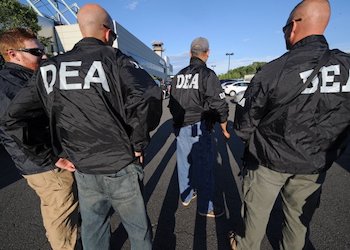American officials are reporting that the Jalisco Cartel – New Generation (CJNG) has expanded its trafficking operations in the United States, marking an important evolution in the modus operandi of the growing criminal organization.
As reported by Proceso, the CJNG has used its growing presence in Juárez to boost its participation in US markets for cocaine and heroin. This marks a change in direction for the group whose prominence in Mexico has risen sharply over the past five years, but whose international forays seemed to be mostly limited to trafficking to Europe.
The Proceso report squares with other recent indications from US authorities. In its 2016 National Drug Threat Assessment, published in November, the Drug Enforcement Administration (DEA) reported that the CJNG was one of the six Mexican organizations with the greatest presence in the United States. It has set up distribution hubs in Los Angeles and Atlanta, and also operates in far-flung cities such as Miami, San Antonio, San Francisco, and even Roanoke, Virginia. The most recent assessment reflects an increased presence relative to prior DEA reports.
Other US agencies have also increasingly turned their attention toward the CJNG. In 2015 and 2016, the Treasury Department’s Office of Foreign Assets Control (OFAC) targeted 11 individuals and five businesses for enhanced sanctions under the so-called Kingpin Act, alleging that they all worked as part of the CJNG.
The first people so designated were Nemesio Oseguera Cervantes and Abigael González Valencia, the gang’s founding leaders. (González Valencia was arrested in Mexico in 2015.) Oseguera Cervantes and González Valencia, brothers-in-law who both faced drug charges in the United States in the 1990s, are also the subject of a 2014 federal indictment for drug trafficking in Washington, DC.
The CJNG has a reputation for operating with a lower profile than the Sinaloa Cartel, and certainly none of its leaders ever courted fame the way Joaquín “El Chapo” Guzmán or Ismael “El Mayo” Zambada have for decades. Nonetheless, the CJNG has been associated with multiple acts of spectacular violence in recent months, particularly the discovery of 12 mutilated corpses outside the port city of Manzanillo in January.
InSight Crime Analysis
The DEA reports offer little supporting information for its findings, and the precise nature of the gangs’ presence in the United States remains unclear. Federal cases against known agents of the CJNG remain notably rare, and newspaper archives in some of the towns where the group is said to operate have no local reporting on arrests of CJNG figures.
Most likely, the DEA report primarily reflects the CJNG’s role in supply chains feeding consumer markets around the United States. Compared to the possibility of Mexican gangs transferring their most aggressive tactics to American cities, this represents a decidedly more benign, and ultimately inevitable, manifestation of Mexican cartels ties to the United States.
SEE ALSO: CJNG Profile
In any event, the CJNG’s forays into the United States are a natural evolution for a criminal organization that has grown precipitously since its foundation in 2010 as an offshoot of the Sinaloa Cartel. From its origins in Mexico’s central Pacific Coast region, the group has spread across the country. In recent years, it has reportedly operated in the three of the biggest northern border crossings — Nuevo Laredo, Juárez, and Tijuana — as well as in southern seaside cities like Cancún and Playa del Carmen.
The group has also expanded internationally. As noted above, US officials have reported that the CJNG built its business on the European market for cocaine. The group also has a substantial operation in Asia. The US indictment accuses the CJNG of operating in Colombia and Guatemala. González Valencia’s brother and criminal associate Gerardo was arrested in Uruguay, where he lived at least part of the time. Gerardo allegedly ran a laundering operation revealed in the Panama Papers that held assets in China and Russia.
The CJNG’s growth has been enabled and accelerated by the decline of other rival groups, such as the Sinaloa Cartel, the Zetas, the Gulf Cartel, the Tijuana Cartel, and the Knights Templar. All of these organizations, whose existence predates the CJNG’s by many years, have seen prominent leaders arrested or killed over the past five years. Their loosened grip over their key areas of operation has opened the door for the CJNG.
It remains unclear whether the CJNG’s emergence represents the rise of Mexico’s next hegemonic criminal group. But the CJNG’s ascent, filling the void left by other organizations’ reduced status, has brought with it a greater attention from American law enforcement agencies eager for new targets.

